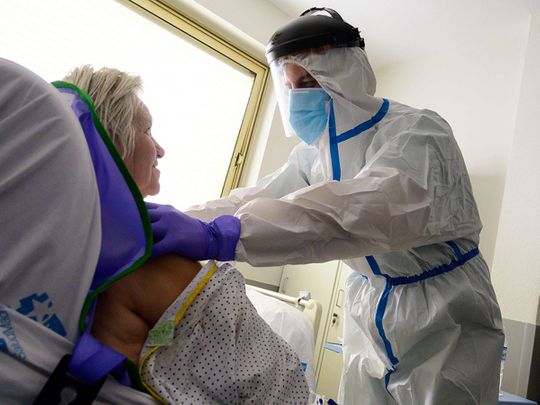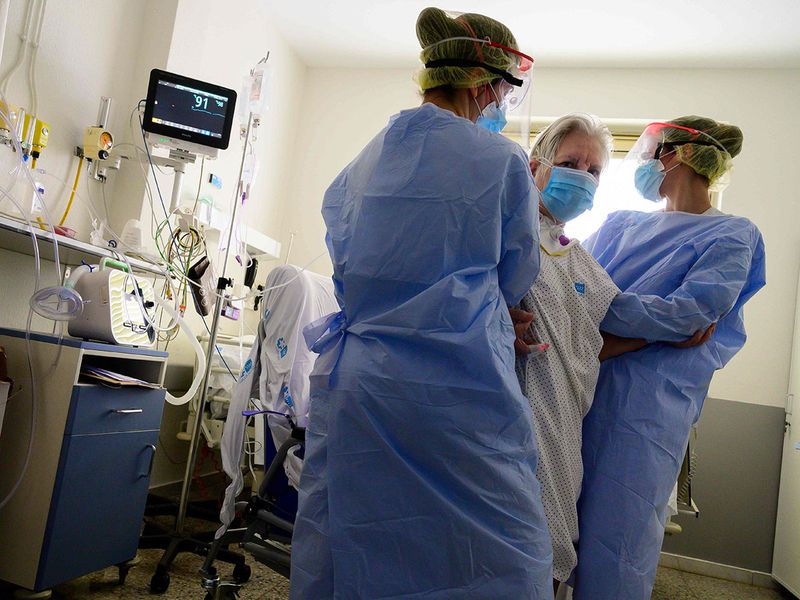
COVID-19: After brush with death, Spanish virus survivor learns to live again
Surviving the infection is just the first step to getting better
by AFPMadrid: After months in a Madrid hospital fighting off the virus that nearly killed her, Rosa Maria Fernandez is now learning the basics again: walking, speaking and using cutlery.
For the 71-year-old, progress is measured incrementally, and even seemingly small victories are reason for celebration.
"Until a week ago, I could hardly speak but now I can," says Fernandez, who was rushed to hospital fighting for breath on March 6, and later tested positive for the virus.
"It is a surprise that I can speak and that you understand me," she says sitting in a wheelchair by her bed, a touch of pride in her newfound voice, which gurgles weakly behind a blue facemask.
Behind her, numbers on a screen carefully monitor her oxygen levels, the medics hovering nearby to see she doesn't overexert herself in her eagerness to talk.
She is one of more the 235,000 confirmed coronavirus cases in Spain, one of the hardest-hit countries in the world.
After weeks of fighting off the illness, she considers herself lucky to have escaped death, in a country where more than 28,000 have perished from the disease.
"I thought I was dying. There were moments when I was struggling so hard to breathe that I couldn't communicate," she croaks, her voice barely audible.
28,000
people have died from COVID-19 in Spain so far.
"It was absolutely awful. I was really out of it... but God has given me a bit more time," she says of the month she spent in intensive care as medics at Gregorio Maranon hospital battled to keep her alive.
"The angel of death passed me by."
Although still very unwell, she's come a long way since she was checked into the hospital.
Like many COVID-19 patients, she was heavily sedated, intubated and put on a ventilator before being discharged when she could breathe on her own.
But leaving intensive care was only the start of a long path to recovery, involving extensive rehabilitation which is still not over.
Recently, she's made a lot of progress - after more than eight weeks in hospital, she has finally managed to sit up and has started to eat on her own.

Survival, but at a price
But survival comes at a price.
Long stints in intensive care often leave a patient with issues that can affect their quality of life, from severe muscle wastage, respiratory weakness and cognitive problems, to speech difficulties, memory loss and anxiety, among others.
And in such cases, rehabilitation is crucial, says Dr Ruben Juarez Fernandez, the 39-year-old rehabilitation specialist whose job is to assess a patient's needs on leaving intensive care.
"It's all about ensuring they have the least possible disability in the future and the fewest after-effects when they go home to their normal life."
Physiotherapist Laura Garcia Montes, 30, has been helping Fernandez regain movement in her limbs, and teaching her breathing exercises to improve lung function.
Although she can't walk yet, learning to sit up has made a big difference, she said.
"Rosa has been in here a long time, it's more than two months. Now she's able to do things, to cooperate more and she's happier and more active so the treatment goes faster."
Working with COVID-19 survivors requires an extra level of care because many suffer nausea or struggle to breathe when changing position.
"Although it takes a bit of work we want to get them back on their feet, so they can sit up without feeling nauseous or without falling over."
'I want a normal life'
As well as sitting up on her own, Rosa has recently regained the use of her hands and is learning how to use cutlery, says Marta Garcia de Francisco, a 39-year-old occupational therapist.
"We see many patients who can't use their hands as they did before, to dress themselves or even to lift a spoon to their mouth," she said.
"It may be because they've been immobile in intensive care which creates muscular weakness or due to neurological problems which we're observing in COVID-19 patients."
They're also working on her core stability so she can eventually be able to stand up and dress herself.
It's not clear how much longer she will have to stay in hospital.
"We're taking it week by week, now we see her sitting up, next is to see if she can stand up (on her own) and how she gets on with things like going to the toilet, dressing and eating," Dr Fernandez says.
"Each moment, we're making her more independent, that's why the rehabilitation service is here."
After her brush with death, Rosa says all she wants is "to live a normal life".
"When I can see an improvement every day, I feel better," she said.
"I've still got a way to go but I'm getting through it."